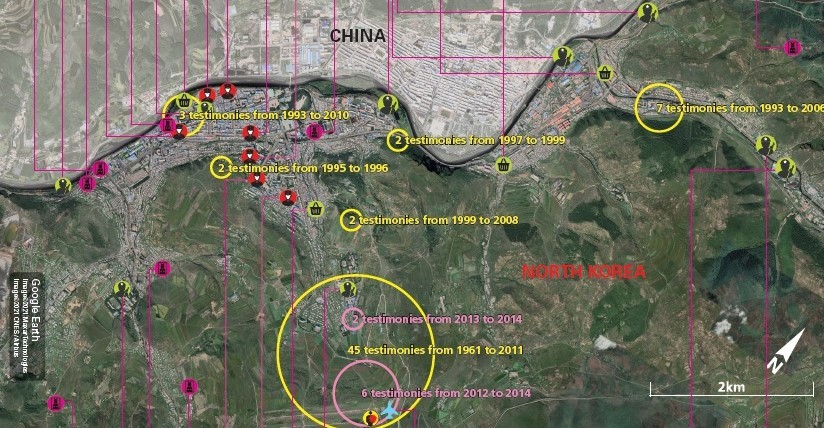North Korea has continued public executions in isolated areas under the Kim Jong-un regime, in an apparent strategic move to prevent the leakage of inside information and avoid international monitoring, a human rights nongovernmental organization said in a report.
The Seoul-based Transitional Justice Working Group on Wednesday released the report “Mapping Killings Under Kim Jong-un: North Korea’s Response to International Pressure” based on interviews with hundreds of North Korean escapees and satellite imagery analyses conducted since 2015.
The TJWG has identified differences in the patterns of public executions during the Kim Jong-un era by focusing on examining the city of Hyesan on the border with China, which is relatively more exposed to the outside world due to its geographical location.
The key dissimilarity is the Kim Jong-un regime carried out most public executions in isolated and inconspicuous places a long way off from the border and central area of the city. The sites for public executions include Hyesan Airfield and nearby hills, mountains, open terrain and fields.
The testimonies of North Korean defectors also suggested that public executions have not been staged in the center of Hyesan or places near the border with China during the Kim Jong-un era, unlike the previous period.
Also noteworthy, the number of locations mainly used for public executions in Hyesan decreased under Kim Jong-un’s rule.
The TJWG said the change in patterns could be Pyongyang’s response to the international community’s criticism and a strategic move. The Kim Jong-un regime chose public execution sites where it could easily control people in attendance and block leaks of information, including video footage.
“One explanation could be that North Korea is strategically selecting execution sites where it is easier to prevent potential information leaks,” the human rights advocacy group said.
“This change in location may provide an explanation of how the state’s action is being influenced by the scrutiny of the international community.”
The Kim Jong-un regime also tightened monitoring and control over the North Korean people forced to watch public executions with various measures, including advanced metal detectors.
The TJWG assessed that the North Korean leadership has systematically continued state-sanctioned killings involving the Ministry of State Security, the Ministry of Social Security and the Defense Security Command.
Pay attention to secret executions But the Kim Jong-un regime conspicuously appears to be more sensitive about North Korean human rights issues as the international community has stepped up monitoring and investigation and voiced concerns about the country’s violations, including inhumane treatment and punishment.
“Our findings suggest that the Kim Jong-un regime is paying more attention to human rights issues as a response to increased international scrutiny over the gravity of the situation in North Korea,” said Park Ah-yeong, the report’s lead author.
“This does not mean the human rights situation in North Korea is improving; state-led killings continue to take place in ways that may not be as visible to the public as they did in the past.”
The TJWG reiterated that the Kim Jong-un regime’s pursuit to avoid the international community’s monitoring and scrutiny raised the necessity to pay more attention to secret executions taking place behind closed doors.
The testimonies of North Korean defectors also suggested that the number of public executions decreased while Pyongyang has continued to secretly kill people at indoor places.
“Documenting secret or ‘indoor’ killings is our next step. There are an increasing number of news reports quoting clandestine information sources inside North Korea about this type of killing in the last five to six years,“ TJWG Executive Director Lee Young-hwan said.
The TJWG interviewed 683 North Korean defectors for six years, and 200 of the total participants lived in North Korea after Kim Jong-un took power in December 2011.
The report, funded by the Washington-based National Endowment for Democracy, included 442 “credible testimonies” for state-sanctioned killings from 1956 to 2018.
In general, the Kim Jong-un regime conducted public executions at locales including open spaces, fields, airfields, riverbanks, hills and mountains with the attendance of hundreds of North Korean people, including families of the persons executed.
The most commonly cited charges for public execution were watching or distributing South Korea-produced video, drug-related crimes, prostitution, human trafficking and murder or attempted murder, as well as “obscene acts.” However, North Korean authorities can freely fabricate charges considering the lack of due process in the judicial system.
The report also said the Kim Jong-un regime has continued its reign of terror with inhumane treatment of the accused before the public execution, and pointed out that Pyongyang’s frequent inhumane violence had numbed the people to public executions.
“North Korea has normalized theatrical and gratuitous violence to the extent that many interviewees have reported becoming desensitized to public killings,” the TJWG said in the report.
The TJWG underscored that the Kim Jong-un regime’s “continued practice of systematic and widespread human rights violations” shows the urgency of raising public awareness of human rights within North Korean society.
By Ji Da-gyum (
dagyumji@heraldcorp.com)







![[Today’s K-pop] Blackpink’s Jennie, Lisa invited to Coachella as solo acts](http://res.heraldm.com/phpwas/restmb_idxmake.php?idx=644&simg=/content/image/2024/11/21/20241121050099_0.jpg)
